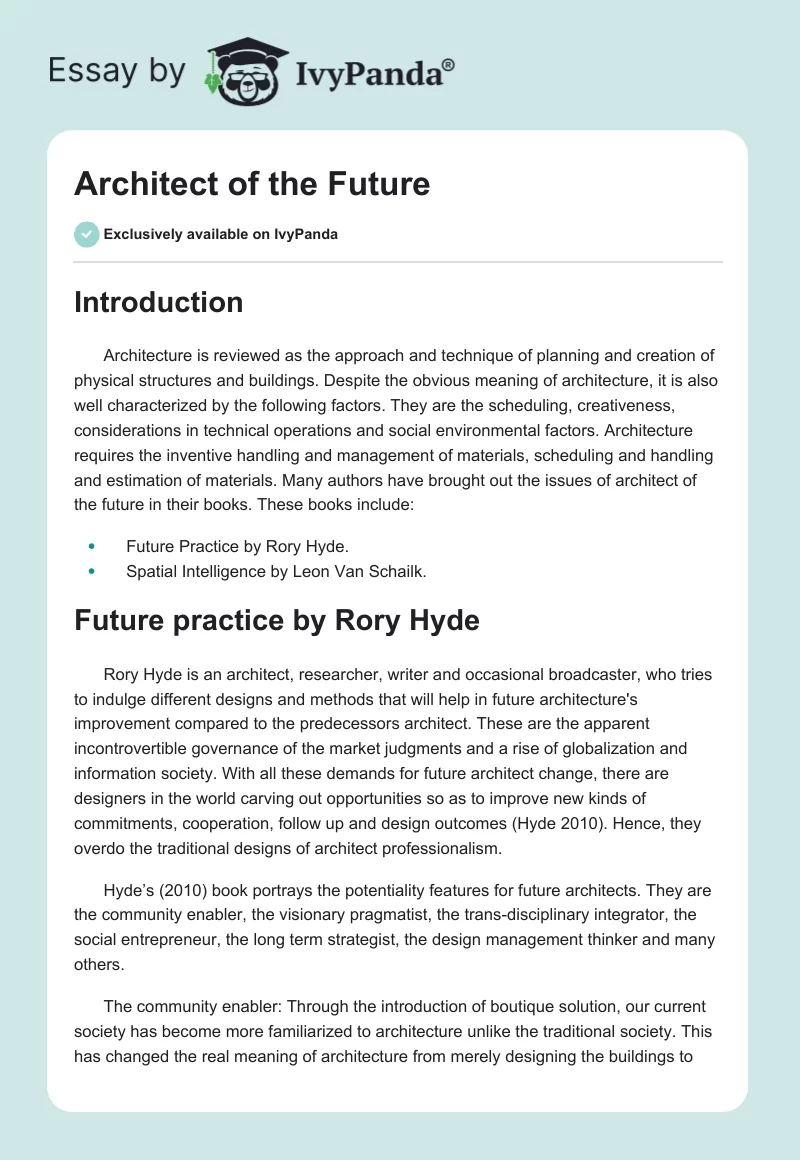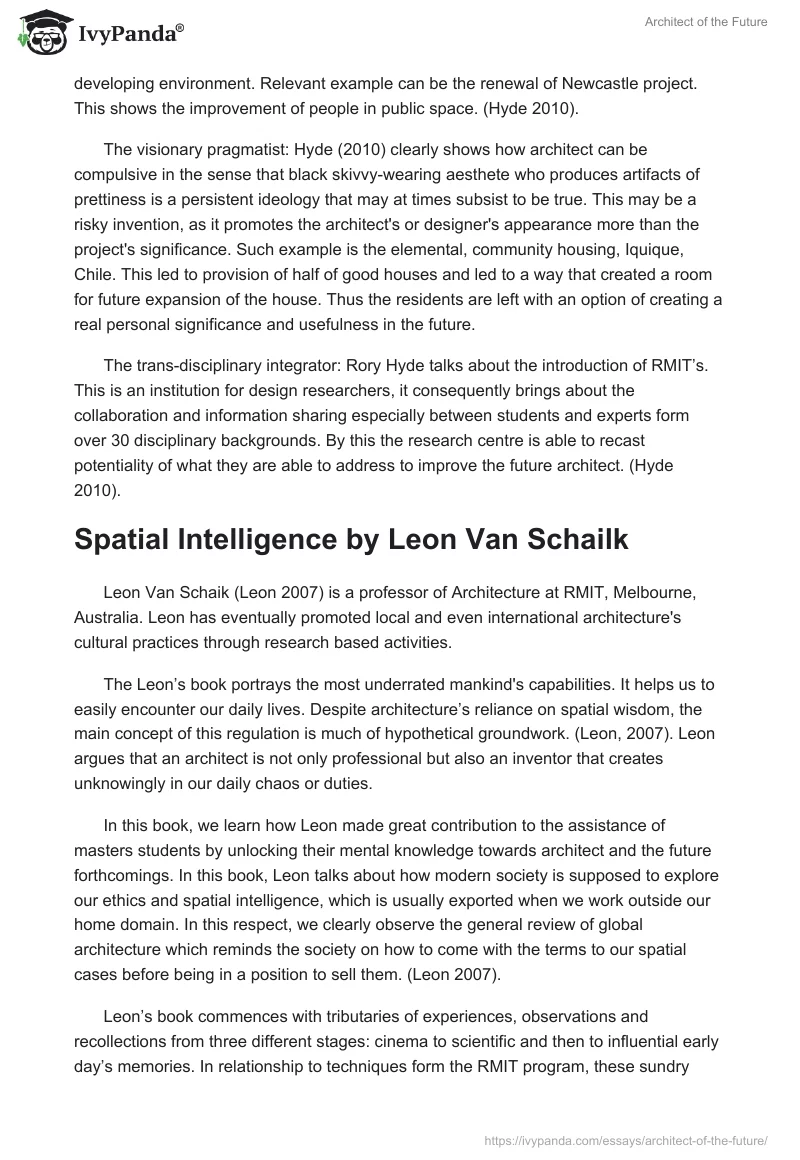Introduction
Architecture is reviewed as the approach and technique of planning and creation of physical structures and buildings. Despite the obvious meaning of architecture, it is also well characterized by the following factors. They are the scheduling, creativeness, considerations in technical operations and social environmental factors. Architecture requires the inventive handling and management of materials, scheduling and handling and estimation of materials. Many authors have brought out the issues of architect of the future in their books. These books include:
- Future Practice by Rory Hyde.
- Spatial Intelligence by Leon Van Schailk.
Future practice by Rory Hyde
Rory Hyde is an architect, researcher, writer and occasional broadcaster, who tries to indulge different designs and methods that will help in future architecture’s improvement compared to the predecessors architect. These are the apparent incontrovertible governance of the market judgments and a rise of globalization and information society. With all these demands for future architect change, there are designers in the world carving out opportunities so as to improve new kinds of commitments, cooperation, follow up and design outcomes (Hyde 2010). Hence, they overdo the traditional designs of architect professionalism.
Hyde’s (2010) book portrays the potentiality features for future architects. They are the community enabler, the visionary pragmatist, the trans-disciplinary integrator, the social entrepreneur, the long term strategist, the design management thinker and many others.
The community enabler: Through the introduction of boutique solution, our current society has become more familiarized to architecture unlike the traditional society. This has changed the real meaning of architecture from merely designing the buildings to developing environment. Relevant example can be the renewal of Newcastle project. This shows the improvement of people in public space. (Hyde 2010).
The visionary pragmatist: Hyde (2010) clearly shows how architect can be compulsive in the sense that black skivvy-wearing aesthete who produces artifacts of prettiness is a persistent ideology that may at times subsist to be true. This may be a risky invention, as it promotes the architect’s or designer’s appearance more than the project’s significance. Such example is the elemental, community housing, Iquique, Chile. This led to provision of half of good houses and led to a way that created a room for future expansion of the house. Thus the residents are left with an option of creating a real personal significance and usefulness in the future.
The trans-disciplinary integrator: Rory Hyde talks about the introduction of RMIT’s. This is an institution for design researchers, it consequently brings about the collaboration and information sharing especially between students and experts form over 30 disciplinary backgrounds. By this the research centre is able to recast potentiality of what they are able to address to improve the future architect. (Hyde 2010).
Spatial Intelligence by Leon Van Schailk
Leon Van Schaik (Leon 2007) is a professor of Architecture at RMIT, Melbourne, Australia. Leon has eventually promoted local and even international architecture’s cultural practices through research based activities.
The Leon’s book portrays the most underrated mankind’s capabilities. It helps us to easily encounter our daily lives. Despite architecture’s reliance on spatial wisdom, the main concept of this regulation is much of hypothetical groundwork. (Leon, 2007). Leon argues that an architect is not only professional but also an inventor that creates unknowingly in our daily chaos or duties.
In this book, we learn how Leon made great contribution to the assistance of masters students by unlocking their mental knowledge towards architect and the future forthcomings. In this book, Leon talks about how modern society is supposed to explore our ethics and spatial intelligence, which is usually exported when we work outside our home domain. In this respect, we clearly observe the general review of global architecture which reminds the society on how to come with the terms to our spatial cases before being in a position to sell them. (Leon 2007).
Leon’s book commences with tributaries of experiences, observations and recollections from three different stages: cinema to scientific and then to influential early day’s memories. In relationship to techniques form the RMIT program, these sundry collections of references are coaxed or herded towards a ‘eureka moment’ which concurrently is brought by the frail astuteness as described by Sola-Morales. A good example in this book is the breadth of Van Schaik’s interests (boat hulls). This is specifically designed for particular waterways or in other words the rightness of forms that respond to exacting climatic or topographical context. Through this, Van Schaik smoothly glides across the astonishing breadth of spatial references with the careful hand of an instructor, a sensitive architect and design. (Leon 2007).
In this book, Leon (Leon 2007) explains the development of spatial intelligence to the improvement of future architect through various attributes. Through the work of Zumthor, Godsell, Herzog and de Meuron, Finland and Hadid, we can conclude that these groups of people exhibit various conscious care for the society through focusing on the future improvement of architects.
Work citations
Hyde, R. (2010) “Measuring the Presence of Consultants” Koolhaas, MA: R & Reisz, T.
Leon, V. (2007). Spatial Intelligence of Architects of the future. California, MA: Wiley & University of California.


